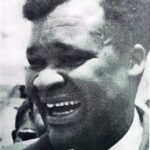OKOMFO ANOKYE
- 4 Min Read
Okomfo Anokye (circa 1660? – circa 1712?), a folk hero who was also a historical figure, was a renowned fetish priest who exerted great influence in Asante in the late 17th and early 18th centuries. It was he who is reputed to have brought down from the sky the Golden Stool containing the soul of the Asante Nation.
Tradition states that he was a native of Awukugua in Akuapem, in the southeast of what is now Ghana, and that because of his great magical powers he was courted by the rulers of his day. The magical element is, however, so strong in the legend connected with him that it is sometimes difficult to distinguish truth from fiction.

PHOTO CAPTION: Okomfo Anokye. SOURCE: theasantenation
It is said that Okomfo Anokye met Osei Tutu, the founder of the Asante nation either at the court of Boa Amponsem, the Denkyerahene (ruler of Denkyera, a state to the south of Asante), or at that of Ansa Sasraku I, the Akwamuhene (ruler of Akwamu, northwest of Accra). The two men must have realised that their qualities were complementary. Okomfo Anokye was a crafty man of affairs, but had no political base, whereas Osei Tutu, who was their heir presumptive to the stool of Kwaman (now Kumase), was a man of action, but needed Okomfo Anokye’s wisdom and knowledge of the world.
In Kwaman, to which the two men went after the death of Obiri Yeboa, Osei Tutu’s uncle, Okomfo Anokye became Osei Tutu’s strong right arm as he began to rule, Okomfo was the great diviner, diplomat, and constitutional expert at what became the court of the Asante Confederacy. In matters of law and custom he left a tradition that was long to endure. His greatest achievement, however, was the creation of the Golden Stool of the Asante. Asante tradition states that one Friday a great gathering of chiefs of the Asante union was held at Bantama, in what is now Kumase. At that meeting, Okomfo Anokye brought down from the sky, amidst darkness, thunder, and in a thick cloud of white dust, a wooden stool decorated with gold which floated down to earth and alighted on Osei Tutu’s knees. Okomfo Anokye then announced that the golden stool contained the sunsum, or spirit, of the Asante, and that the strength of the nation depended upon the safety of the stool.

PHOTO CAPTION: The Golden Stool. SOURCE: gbcghanaonline
Stripped of its legendary origins, the tale indicates the astute statesmanship of the priest. By making the new stool the repository of national glory, Okomfo Anokye impressed upon a people hitherto mistrustful of one another, that henceforth Asante was a nation, linked together by a mystical bond of which the new stool was the visible symbol. The Golden Stool supplied the religious basis of the Asante Union, and it is significant that despite many vicissitudes it still survives today with its unifying power unimpaired.
Before bringing the Golden Stool to earth, Okomfo Anokye had planted three seedlings of the kumnini, or “kill-the-python”, tree (Lannea acidissima) at Kwaman, at Dwaben, about 15 mi (24 km) to the northeast. The seedlings planted at Dwaben and Kumawu died while that at Kwaman lived, and this was interpreted by Okomfo Anokye as a sign that Osei Tutu had been divinely chosen to lead the Asante nation. The name “Kwaman” was thereupon changed to “Kumase,” meaning “under the kumnini tree”.
Okomfo Anokye’s great contribution in the welding together of the Asante nation earned him the stool of one of the divisions of the union. He became the Omanhene (paramount chief) of Agona, northeast of Kumase, and his descendants acted as the traditional diviners of the kings of Asante.
J.K. FYNN




